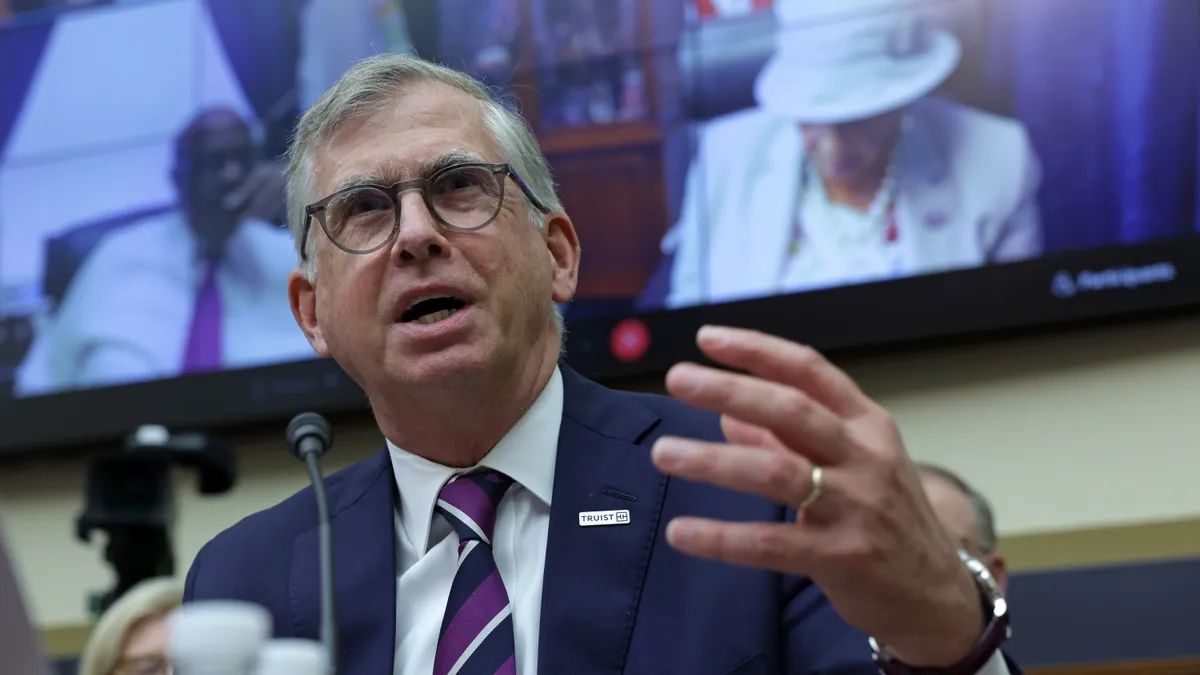Dive Brief:
- Truist CEO Bill Rogers on Thursday said the bank remains focused on streamlining expenses after announcing “sizable reductions” last year.
- “We felt we needed to have a little bit of a shock to the system,” Rogers said Thursday at a Bernstein conference.
- Where Truist’s expense base had been growing by mid-single digits previously, the bank has said it expects to keep expenses flat this year, Rogers noted. But he shied away from making a commitment with regard to 2025.
Dive Insight:
Despite efficiencies realized through the 2019 merger of SunTrust and BB&T, Truist announced in September it was undertaking a significant cost-cutting effort as “the next phase,” Rogers said.
The effort was intended to shave $750 million in expenses over 12 to 18 months, with workforce reductions accounting for $300 million of that. The bank also sought to reduce technology spending, consolidate certain business lines and shrink its branch network.
Truist created a specific program to “reorient ourselves” as it embarked on the overhaul, “and that’s been really successful,” Rogers said Thursday. Still, getting there has required “a lot of discipline, it required a lot of intensity,” he said.
The bank in February announced it would sell its remaining stake in its insurance arm — a deal that finalized this month, providing Truist with $10.1 billion in after-tax cash proceeds.
Truist in February also agreed to sell its asset-management subsidiary, Sterling Capital Management, for $70 million.
In seeking to simplify the business, Truist executives have tried to step back and look for ways to be more efficient across platforms — including with systems or credit approvals — rather than operating in various siloes, Rogers said Thursday.
“Every day, they’re thinking about, ‘OK, if I save a dollar, I can invest a dollar,’ and be in that kind of mode,” Rogers said. “That’s an important catalyst to come out of the merger.”
As far as the bank’s approach to expenses in the coming years, “when we see growth, we’re going to be [in] the front-foot, athletic position to take advantage of that,” Rogers said.
And because expenses may come with that growth pursuit, “I don’t want to commit to a level, until we have a better understanding of where the growth opportunities are going to be,” he added.
One area where Truist has cut back is headcount.
As of March, Truist had 49,218 full-time employees, according to a securities filing. That’s down by more than 3,500 workers, or roughly 8%, from a year earlier. A Truist spokesperson didn’t immediately respond to a request for comment on the number of employees let go through the cost-cutting effort.
Rogers said Truist plans to add people and resources in its wealth business. The bank is also eyeing opportunities to expand branch networks within some markets, Rogers said. That effort comes, though, after a move to close 72 of the banks’ locations during this year’s first quarter.
During the same three-month span, the bank’s non-interest expenses dropped 2% year over year, to about $3 billion. Truist also logged $70 million in restructuring charges in that time, compared with $183 million in 2023’s fourth quarter.
Rogers said Thursday the bank would remain focused on positive operating leverage and maintaining efficiency. Truist expects revenue to decline 0.5% to 1.5% this year, from $20.2 billion in 2023.
Correction: This story has been updated to reflect Truist’s current revenue guidance for 2024.














